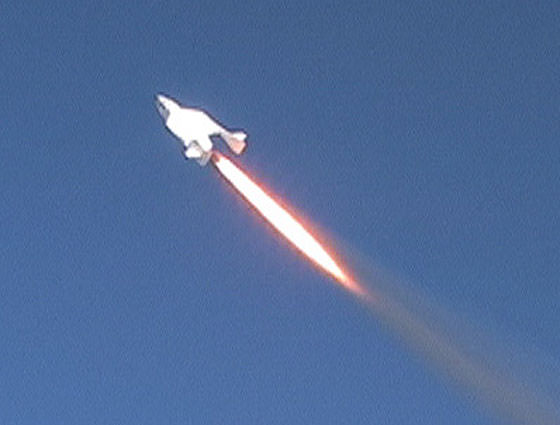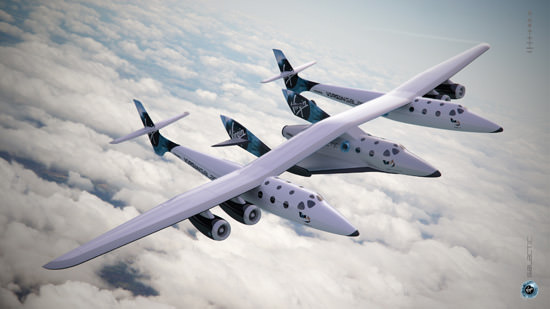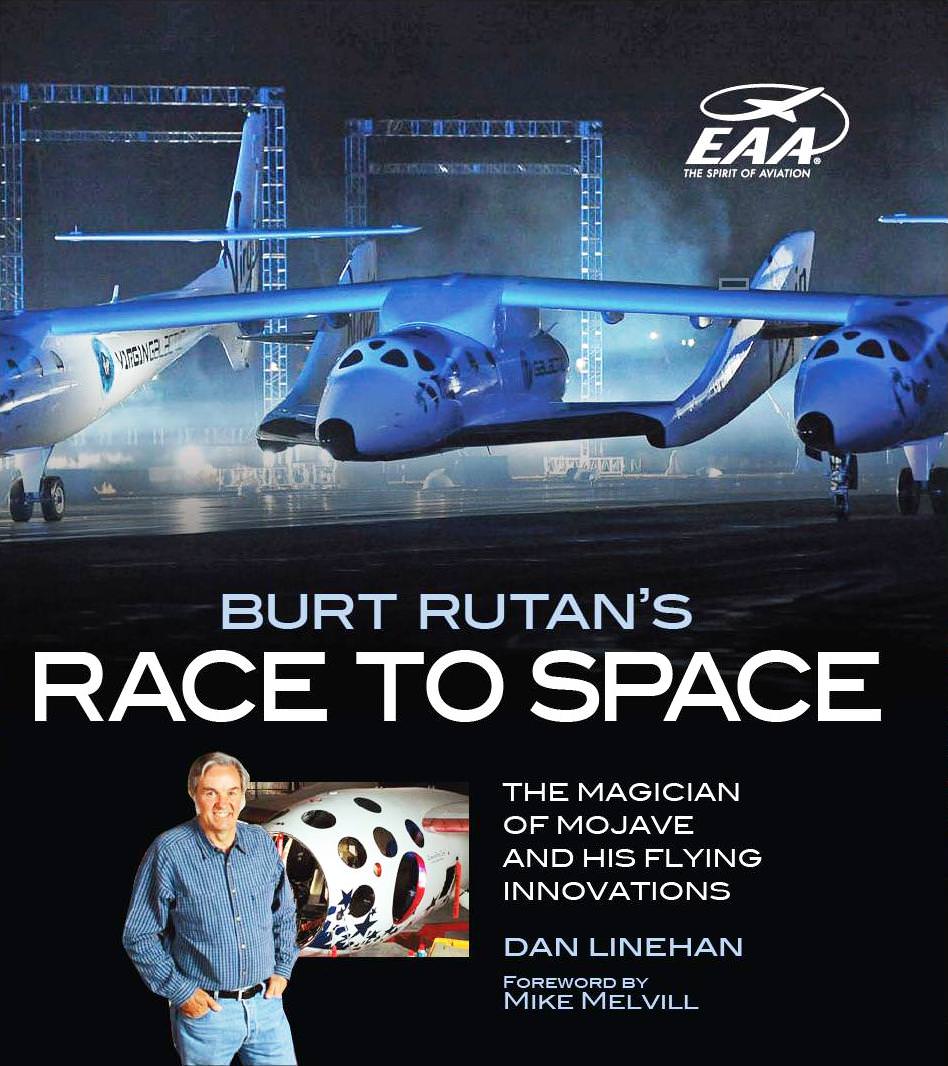[/caption]
Voyager, Proteus and SpaceShipOne have become aerospace legends. As has the man who established them all – Burt Rutan. Zenith Press has released a chronicle of the man and his machines entitled Burt Rutan’s Race to Space: The Magician of Mojave and His Flying Innovations. The book provides a chronicle of all the air and spacecraft that have soared off of Rutan’s blueprints and into reality.
The book’s first main segment is a large section which is essentially a catalog of the numerous craft that Rutan has produced over the decades. Many of the flying machines have their unique characteristics highlighted within the 160 pages of this book. Fear not, this tome is wallpapered with images – most of which are color (175 color images to 55 black and white).

Some of the most interesting of these images are not the glossy stills of air or spacecraft in action but rather the simple drawings that are done by the man himself. These sketches, some little more than cartoons others just simplistic line-drawings, highlight the genius that is Rutan and provide an insight into how his mind works.
The nature of the book changes somewhat when one reaches the chapter entitled, “The Scaled Composites Years.” From this point on, the book’s focus narrows to concentrate on Rutan’s X-PRIZE efforts – and beyond.

The book was written by Dan Linehan and is his second detailing the efforts of Rutan and Scaled Composites (the first was SpaceShipOne: An Illustrated History). In short, the freelance writer is steeped in all things Rutan. Whereas his first work on the subject covered the history-making flight of SpaceShipOne, this effort is a general overview of Rutan and his legacy. But be forewarned, there are many projects that span the entire realm of aerospace that Rutan and company have been involved with that might surprise you.
Given that the Mojave “magician” has retired recently – this book is timely, enjoyable and acts as a wonderful window into the mind of the man that has revolutionized flight. SpaceShipTwo continues to successfully complete test after test – making Burt Rutan’s Race to Space a primer for things to come. The book retails for $30, and it is well-worth the price and will be a welcome addition to any space buff’s collection.



I doubt that the deaths of 3 of his employees in an explosion at an engine test in 2007 are given much room. The three dead persons had been given insufficient safety education by Rutan’s company and the company got fined because of it.
Sometimes, all the safety training in the world is no help, when something as sudden as an unexpected explosion happens.
And this is why it was a matter for OSHA and not, say, the FAA.
Except in this case they would have survived unharmed if they would have just gone behind a safety wall. Telling employees do that isn’t really “rocket science”….
I doubt that the deaths of 3 of his employees in an explosion at an engine test in 2007 are given much room. The three dead persons had been given insufficient safety education by Rutan’s company and the company got fined because of it.
I doubt that the deaths of 3 of his employees in an explosion at an engine test in 2007 are given much room. The three dead persons had been given insufficient safety education by Rutan’s company and the company got fined because of it.
I doubt that the deaths of 3 of his employees in an explosion at an engine test in 2007 are given much room. The three dead persons had been given insufficient safety education by Rutan’s company and the company got fined because of it.
“SpaceShipTwo being carried underneath White Knight Two is currently being tested in preparation to send average citizens into suborbital space.”
Sorry. Anyone who can pay more than many Americans earn in ten years for a 3+ hour joyride into space is not ‘average’.
I tend to second this opinion. This race to privatize space gives me the cold sense that space science will diminish and joy rides for the wealthy will fill that void. This is clearly something only those with $200,000 that can be easily thrown around will engage in. That is a significant chunk of a successful retirement plan built up over multiple decades. This also goes for the Bigelow plan for an orbital hotel, with its check in price of $25 million.
The thing being ignored is that space flight is dangerous. The faster you go the more energy is involved and more fuel is needed. This means there is a near zero fault tolerance on this stuff. If Spaceship 2 runs into trouble there will be no need for “place your folding table in the upward locked position.” No you will just die. Spaceship 2 might successfully make a number of suborbital flights, and then on maybe the 38th flight the craft is smithereens across Dona Ana county, and some big wealth people are dead; people who’s family’s have big lawyers. That might put the kibosh on this.
LC
Average? I’m not sure I would classify those who can afford the ticket price as “average”.
Average? I’m not sure I would classify those who can afford the ticket price as “average”.
Average? I’m not sure I would classify those who can afford the ticket price as “average”.
Almost any high tech product you can think of started out being too expensive for most people. Did you buy a VCR when they cost $2000? Neither did I. But without the wealthy early adopters these products would never survive to become mass market items. I’m smelling some sour grapes…
That is probably a wrong comparison. It would be correct if there were another factor; energy was nearly inexhaustible and the price of energy exponentially decreased with demand. That is the exception. If this craft could be run at the energy cost of running an aircraft of comparable size, then your prognostication might be correct. Energy scales with velocity as E = (1/2)mv^2. An average passenger plane flies at v = 800km/hr or 500 mi/hr. This suborbital craft flies at nearly 6400km/hr, or 8 times as fast. This is then 64 times the kinetic energy per unit mass. Of course you also have to factor in other costs with high stress materials and specialized manufacturing.
So in general one might ask whether the cost of oil is going down. Nope! Is it ever likely to go down, particularly given we are near the peak oil point? Nope!
LC
Actually, if you look at the energy expenditure for spaceflight you will see good prospects for drastic price reductions. The cost of the fuel for orbital rockets is only 2-3% of the total cost. And as you point out, suborbital energy requirements are substantially less. The main cost driver of spaceflight is the vehicle. This is just the sort of area where technological progress can be expected if market forces come to bear, just like VCRs and all the other trinkets of modern life.
As a percentage fuel costs are only about 5%, which is the figure I recall, but that is still substantial. The vehicle cost is substantial, where even for reusable rockets the refurbishing costs are high. The Concord SST was cancelled because of high costs.
Electronics obeys a rapid Moore’s law drop in costs because components can be miniaturized almost endlessly. Certain technologies can’t be miniaturized, and for instance the cost of a car today is proportionately not that different from the 1960s. Similarly the cost of rocketry is not likely to fall precipitately either. Aviation is general is similar, where it is a big investment to own a Cessna 170 type airplane. Jet powered planes are largely out of everyone’s reach. There has been no Moore’s law drop in the cost of combat capable aircraft. Rockets are a similar case, as with other large complex systems, eg submarines.
If there was a general economic trajectory in this direction I don’t think the Concord would have been cancelled and we might all have flying vehicles and so forth. There is a sort of “Hey dude, where’s my jetpack?” issue here. We can have iPhones with more computing power than a 1970 level mainframe computer, but we don’t have lots of other things people thought we would back in the 1950s.
LC
You’re changing your argument. And 5% is too high, even for a low cost vehicle like Falcon 9. You do have a valid point about electronics being an especially dramatic case of declining costs. However, I don’t think that rockets are nearly as technologically mature as cars or planes. We don’t throw the plane away after each flight, do we? Or wheel it to a hangar for six months of refurbishing. And it doesn’t take thousands of engineers and mechanics to keep each plane flying.
But I got into this discussion to criticize the sour grapes attitudes of those who sneer at Virgin Galactic’s $200,000 ticket price. Just because it now seems to be only a rich man’s plaything, don’t assume that’s all it will ever be. If a true market develops for space travel, you can expect to see dramatic advances in coming years.
That is probably a wrong comparison. It would be correct if there were another factor; energy was nearly inexhaustible and the price of energy exponentially decreased with demand. That is the exception. If this craft could be run at the energy cost of running an aircraft of comparable size, then your prognostication might be correct. Energy scales with velocity as E = (1/2)mv^2. An average passenger plane flies at v = 800km/hr or 500 mi/hr. This suborbital craft flies at nearly 6400km/hr, or 8 times as fast. This is then 64 times the kinetic energy per unit mass. Of course you also have to factor in other costs with high stress materials and specialized manufacturing.
So in general one might ask whether the cost of oil is going down. Nope! Is it ever likely to go down, particularly given we are near the peak oil point? Nope!
LC
Bill – privatized space travel is nothing like a VCR. Primarily because a VCR can’t kill you when it fails.
While that is true it does not make spaceflight unique, nor does it make it immune to market forces. What has been missing in spaceflight is a robust commercial market. My point about the Virgin Galactic prices is that once a service exists and people are buying it, prices will tend to come down. There is no fundamental technological barrier to that happening. Lcrowell mentioned energy costs, but as I explained, prices can decline substantially before that becomes an issue.
I don’t think you’re comparing apples to apples here. Certainly costs will come down as technology advances, but as others have stated to compare manned spacecraft to the production of electronic devices doesn’t square logically. LC’s Jet aircraft example points this out rather clearly.
Furthermore, while manned spaceflight may not be immune to market forces, it certainly doesn’t follow the same supply and demand curve as affordable commodity products.
I think the prices will come down as well. Back in the 1930’s an airline ticket from coast to coast in the US was $260, about half of the price of a new automobile. Only business executives and the wealthy could afford to fly.
I think the prices will come down as well. Back in the 1930’s an airline ticket from coast to coast in the US was $260, about half of the price of a new automobile. Only business executives and the wealthy could afford to fly.
I remember reading a book titled ‘Thrust Into Space” a long time ago. In it were calculations that I did that arrived at a fule mass value for a sub-sonic flight around the globe with a typical 1960’s circa jetliner. The fuel consumed was equal to that required to reach orbital velocity. Now this assumed that both were air breathing systems with very high ISP’s, but it was an interesting exercise non the less. Given that an air breathing system is about 6 times as efficient as one that has to carry all of it’s oxidizer along with it, the mass fraction for a single stage to orbit craft would also be six time heavier. But Space Ship 2 will be carried to an altitude above most of the earth’s atmosphere at close to mach .8 with an air breathing kerosene system and I believe it will reach mach 3 on it’s own power and assume a parabola trajectory. The trickiest part will be controlling the fall back into denser regions of the earth’s atmosphere where flight control surfaces can reliably control the craft’s attitude etc. There will not be any of the extreme forces exerted on it such as what the shuttle incures during re-entry at mach 25 so no need to absorb massive amounts of heat due to friction.
From a fuel usage and braking standpoint, it is a very efficient system and cost should come down once it is produced in a mass manufacturing set up assuming there is enough demand for it at different price points.